Listening in on a powerful volcanic eruption
Scientists, including Assoc Prof Benoit Taisne, unveil the secrets of one of the world's most powerful volcanic eruptions.

When the Hunga Tonga-Hunga Ha’apai volcano erupted on 15 January 2022 in the southern Pacific Ocean, the world witnessed one of the most powerful volcanic eruptions recorded in human history; it was even heard almost 10,000 kilometres away in Alaska.
Seizing the opportunity to study this rare geological event, an international group of scientists, including Assoc Prof Benoit Taisne of NTU’s Asian School of the Environment and the Earth Observatory of Singapore (EOS), examined seismic wave and infrasound recordings captured by monitoring stations around the world, including those from EOS in Singapore.
The recordings revealed that the volcano emitted a type of sound wave, known as a Lamb wave, which circled the globe four times and generated a tsunami in the Pacific Ocean.
As measured by the intensity of the Lamb wave, the Hunga eruption was comparable in size to that of the 1883 Krakatau eruption, one of the most devastating volcanic eruptions in modern history.
The researchers say that a better understanding of such waves can lead to more accurate early warnings of tsunamis caused by volcanic eruptions.
The study “Atmospheric waves and global seismoacoustic observations of the January 2022 Hunga eruption, Tonga” was highlighted on the front cover of the 1 July 2022 issue of Science, DOI: 10.1126/science.abo7063.
The article appeared first in NTU's research and innovation magazine Pushing Frontiers (issue #22, August 2023).


.tmb-listing.jpg?Culture=en&sfvrsn=370a7c71_1)

.tmb-listing.jpg?Culture=en&sfvrsn=ab6472c8_1)

.tmb-listing.jpg?Culture=en&sfvrsn=8fcd2938_1)
.tmb-listing.jpg?Culture=en&sfvrsn=7a33f2b7_1)